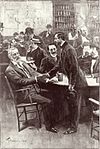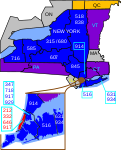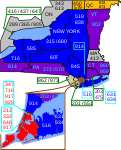The Courant Institute of Mathematical Sciences (commonly known as Courant or CIMS) is the mathematics research school of New York University (NYU), and is among the most prestigious mathematics schools and mathematical sciences research centers in the world. Founded in 1935, it is named after Richard Courant, one of the founders of the Courant Institute and also a mathematics professor at New York University from 1936 to 1972, and serves as a center for research and advanced training in computer science and mathematics. It is located on Gould Plaza next to the Stern School of Business and the economics department of the College of Arts and Science.
NYU is ranked #1 in applied mathematics in the US (as per US News), #5 in citation impact worldwide, and #12 in citation worldwide. It is also ranked #19 worldwide in computer science and information systems. On the Faculty Scholarly Productivity Index, it is ranked #3 with an index of 1.84. It is also known for its extensive research in pure mathematical areas, such as partial differential equations, probability and geometry, as well as applied mathematical areas, such as computational biology, computational neuroscience, and mathematical finance. The Mathematics Department of the Institute has 15 members of the United States National Academy of Sciences (joint third globally with Princeton University, and after the University of California at Berkeley and Harvard University who are joint first globally with 17 members each, and just ahead of other topnotch research universities like Stanford University which has 14 members) and five members of the National Academy of Engineering. Four faculty members have been awarded the National Medal of Science, one was honored with the Kyoto Prize, and nine have received career awards from the National Science Foundation. Courant Institute professors Peter Lax, S. R. Srinivasa Varadhan, Mikhail Gromov, Louis Nirenberg won the 2005, 2007, 2009 and 2015 Abel Prize respectively for their research in partial differential equations, probability and geometry. Louis Nirenberg also received the Chern Medal in 2010, and Subhash Khot won the Nevanlinna Prize in 2014. In addition, Jeff Cheeger was also awarded the Shaw Prize in Mathematical Sciences in 2021.The Director of the Courant Institute directly reports to New York University's Provost and President and works closely with deans and directors of other NYU colleges and divisions respectively. The undergraduate programs and graduate programs at the Courant Institute are run independently by the Institute, and formally associated with the NYU College of Arts and Science, NYU Tandon School Of Engineering, and NYU Graduate School of Arts and Science respectively.








